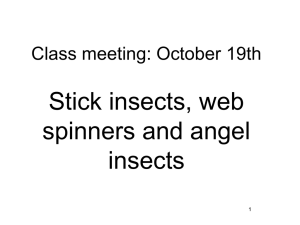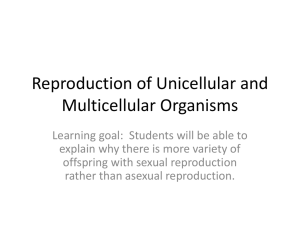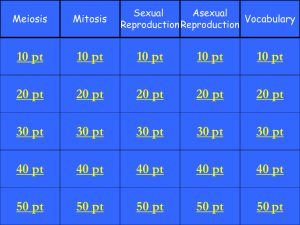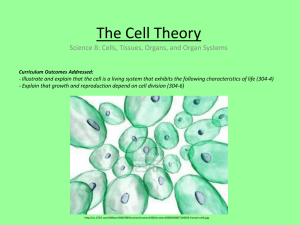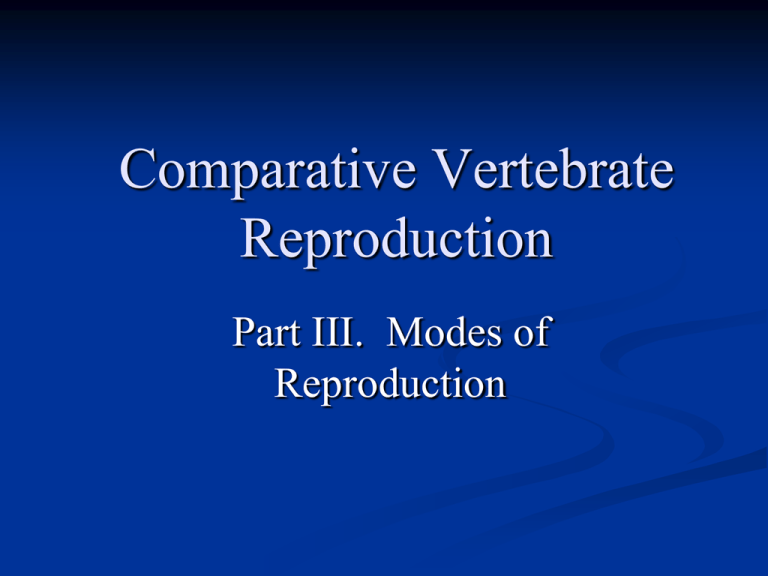
Comparative Vertebrate
Reproduction
Part III. Modes of
Reproduction
Introduction and Overview
The Vertebrate Life Cycle
Sexual Reproduction
Meiosis
Costs of Sexual Reproduction
Benefits of Sexual Reproduction
Unisexual Reproduction
Parthenogenesis
Gynogenesis
Hybridogenesis
The Vertebrate Life Cycle
Typical prolonged diploid phase and a much
shorter haploid phase.
Diploid Phase
Certain cells form a germ cell line.
These cells give rise to primordial germ cells.
PGCs divide into gonial cells.
Somatic cell line – cells other than PGCs.
In a majority of cases, PGCs migrate from their place
of origin to the gonads.
Once in the gonads, the PGCs differentiate into stem
cells that undergo mitosis and give rise to gonial cells
that undergo meiosis to produce gametes.
This process in both sexes in known as sexualization.
Haploid Phase
Onset of meiosis in gonial cells.
Several hours to several years to occur
In most vertebrates, the end of the haploid
phase and the beginning of a new life cycle
occurs at the time of fertilization.
In a few unisexual species, onset of a new
cycle begins with the activation of an ovum
without the genetic contribution of a sperm.
Sexual Reproduction
Sex at the cellular level involves the
production and subsequent combination of two
distinct genomes.
By contrast, reproduction involves the
generation of a new individual.
Sexual reproduction involves both processes.
These definitions may seem trite at the moment, but must be
considered due to the presence of unisexual vertebrates.
Meiosis I
Events
1. Five stages
of Prophase I (see next slide)
leptotene – sister chromatids appear
called dyads
zygotene – pairing of dyads –
process called synapsis
giving rise to tetrads
pachytene – chromatids shorten and
crossing over occurs
diplotene – homologues begin to
separate, yet remain
attached at sites where they
crossed over - chiasmata
diakinesis – chiasmata undergo jumping,
further shortening, and begin
migration to metaphase plane
2. Metaphase I ; 3. Anaphase I;
4. Telophase I and cytokinesis
Cell Wheel for Spermatogenesis in the Mississippi Map Turtle,
Graptemys pseudogeographica kohnii
Interkinesis – brief period of
interphase
Meiosis II
More rapid than meiosis I
No specialized prophase
During metaphase II, sister chromatids align on the
metaphase plane
Sister chromatids separate during anaphase II
After cytokinesis during telophase II, each resulting
cell is left with a single sister chromatid.
Summary of Mitosis and Meiosis
Costs of Sexual Reproduction
Cost of Anisogamy – female contributes more energy in the
production of a single viable gamete than do males
Cost of Meiosis – gametes carry only ½ the genetic
complement of the parent
Cost of Genetic Recombination – the dismantling of two
successful genotypes and recombines them in a novel way.
Cost of Mating – energetic costs associated with sexual
dimorphism and sex-specific social behaviors
Human example: Longevity of Sami women (n = 375) with respect
to the gender of offspring born to them. Adapted from Helle, Lummaa & Jokela
2002, Science 296:1085
Benefits of Sexual Reproduction
Increased genetic diversity
Rapid means of generating genetic variability
Recombination of chromosomes and random mating will produce
recombinant genomes with fewer mutant alleles.
Contrasted to: “Muller's Ratchet” (Fisher-Muller Model) - Asexual lineages
will accumulate mutations independently of each other. Some lineages will
have few, if any, mutations, while others will carry a greater number of
deleterious mutants. In a finite population there is a high probability that
the mutant-free class will be lost. The frequency of deleterious mutations
within and among lineages, therefore, will increase.
Muller's ratchet, the inevitable accumulation of deleterious
mutations in asexual populations, has been proposed as a
major factor in genome degradation of obligate symbiont
organisms. Essentially, if left unchecked the ratchet will with
certainty cause extinction due to the ever increasing
mutational load.
Unisexual Reproduction
Reproduction with little or no genetic recombination is referred to
as unisexual reproduction.
Unisexuality is asexual only at the genetic level and often involves
heterosexual and, in some cases, homosexual courtship behavior.
22 piscine taxa, 19 amphibian taxa, and 32 reptilian taxa are
unisexual.
Unisexual taxa are generally all-female “species” that arise through
interspecific hybridization during some time in their evolutionary
history.
Reproduction in hybrid forms is made possible by one or more
aberrations in the premeiotic or meiotic gametogenic mechanism.
Modes of unisexual reproduction include parthenogenesis,
gynogenesis, and hybridogenesis
Comparison between modes of unisexual
reproduction and sexual reproduction
Parthenogenesis
Production of offspring without the involvement of
males.
Parthenogenetic forms are termed parthenotes.
Unisexual diploid or triploid females contain a
genome derived through hybridization between two
or more separate ancestral bisexual species.
Entire hybrid genome is transmitted to the ovum
without genetic recombination giving rise to clones.
Classic North American Example of Parthenoforms:
Lizards within the Genus Cnemidophorus (Aspidoscelis)
Phylogenetic Relationships Among Unisexual
Whiptail Lizards
Mating in the bisexual Prairie Racerunner,
Aspidoscelis sexlineata
Production of unreduced diploid ova by hybrids has resulted in
a clonal reproduction.
Parthenogenetic activation of ova is triggered by a repertoire
of courtship and mating behaviors.
Pseudocopulation in Unisexual Whiptail Lizards
In populations of these females, ovarian cyclicity is
asynchronous.
Females in the vitellogenic phase of the ovarian cycle exhibit “female”
copulatory behavior.
Females in the postovulatory phase exhibit “male” behaviors.
Thus, parthenogenetic mating is a form of homosexual
behavior.
Parthenogenesis has been documented in several species of
Aspidoscelis, in wall lizards (Lacerta), in geckos, chamaelions,
night lizards, and blind snakes.
Reptiles appear to be the only vertebrate class that employs
parthenogenesis as a naturally-occurring feature of
reproduction.
Gynogenesis
Gynogenetic forms are called gynogenotes.
Sperm is required for the activation of embryogenesis, but the
sperm does not contribute to the genome.
The best known example is found in the unisexual teleost fish,
Poecilia formosa, of southern Texas and northeastern Mexico.
Diploid ova are activated by the sperm of a related bisexual species,
P. latipinna.
Other gynogenotes include other
poeciliid species and members of
three other fish families.
Hybridogenesis
In hybridogenetic forms, called hybridogenotes, only half of
the ancestral hybrid’s genome is passed on to subsequent
generations.
The unisexual poeciliid fish, Poeciliopsis monacha-lucida
arise through hybridization between 2 bisexual species.
Other hybridogenotes include biotypes of the frog genus Rana
and “species groups” within the salamander genus Ambystoma.
Hybridogenesis in Water Frogs
Peter Beerli
Costs of Hybridogenesis
Kleptogenesis
– All unisexual
populations
share the same
mtDNA…local
unisexuals
“steal” nuclear
genomes from
sexual males
Cytological Mechanisms of Unisexuality
Interspecific hybridization events that occurred
during the evolution of unisexuality remain
poorly understood.
Two cytological mechanisms have been put
forth: 1) Apomixis, and 2) Premeiotic
endomitosis – Both alter the outcome of oogenesis so
that there is no recombination of genetic material and no
reduction in the ploidy of the ovum.
1-Apomixis* and 2-Premeiotic Endomitosis
1-Normal mechanisms of meiosis are suppressed; i.e., no
pairing of homologous chromosomes, no crossing over, and no
chromosomal segregation. (Only confirmed example is the
gynogenetic poeciliid fish, Poecilia formosa and its related
triploids.) *Apomixis is best understood in angiosperm plants.
2-Aberrant mitotic division prior to the beginning of meiosis
that doubles the ploidy of the cells…no karyokinesis or
cytokinesis. As a result, there is doubling of chromosomal
number. Known to produce unreduced ova in the parthenote
whiptail lizard, Aspidoscelis uniparens, and in some
gynogenetic poeciliid fish hybrids.
Cytological Mechanisms of Unisexuality
Polyembryony
Polyembryony or identical twinning is a modification of the sexual
mode of reproduction that produces multiple individuals from a
single zygote.—involves loss of coherence between blastomeres
during early embryonic development.
One of the few examples of polyembryony is in the nine-banded
Texas armadillo, Dasypus novemcinctus. Four genetically-identical
embryos are derived from a single zygote. The twelve-banded
armadillo produces 7 and 12 genetically-identical offspring.
Nine-banded
Armadillo and
offspring




